
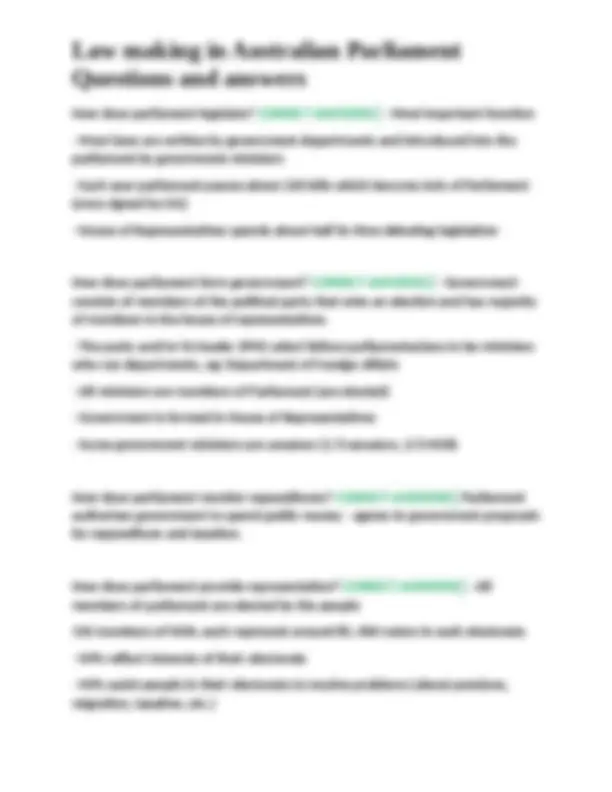
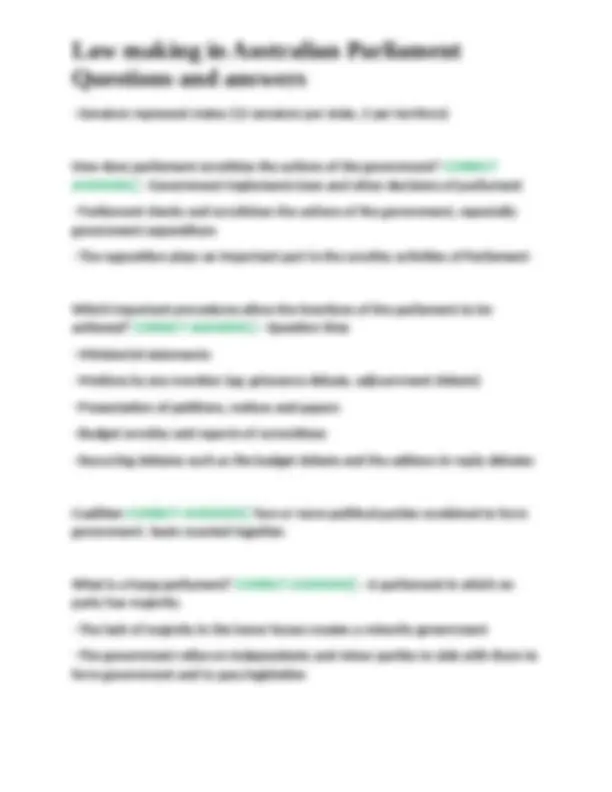
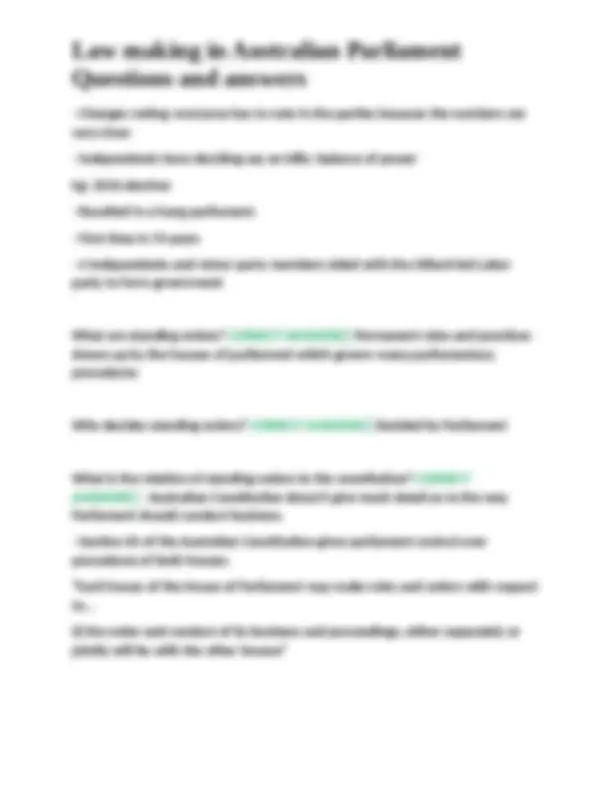
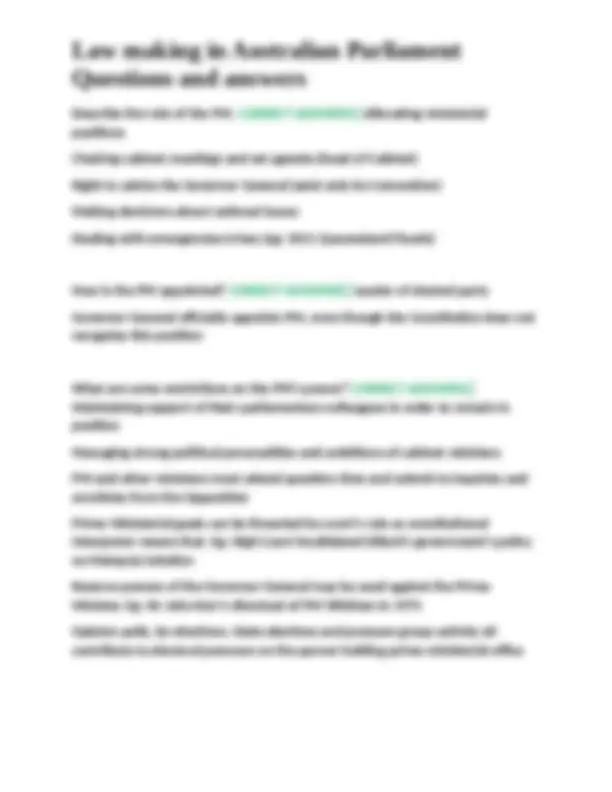
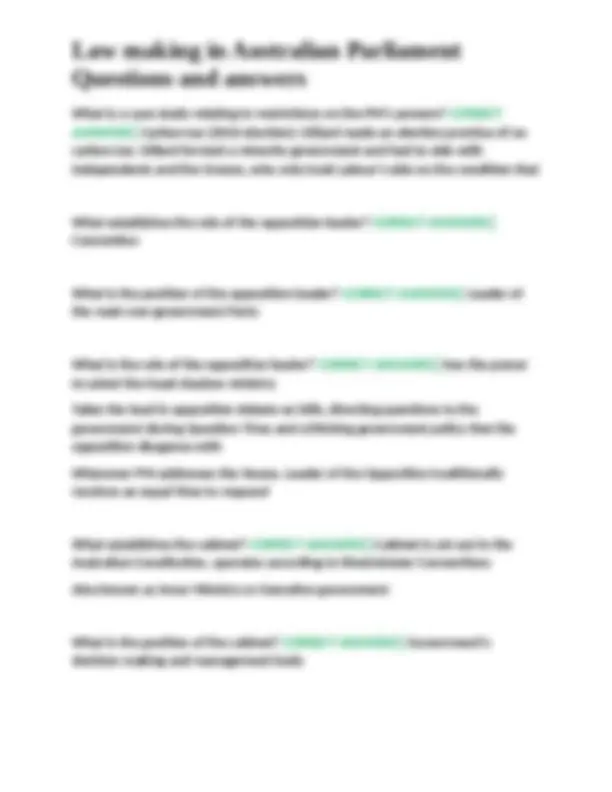
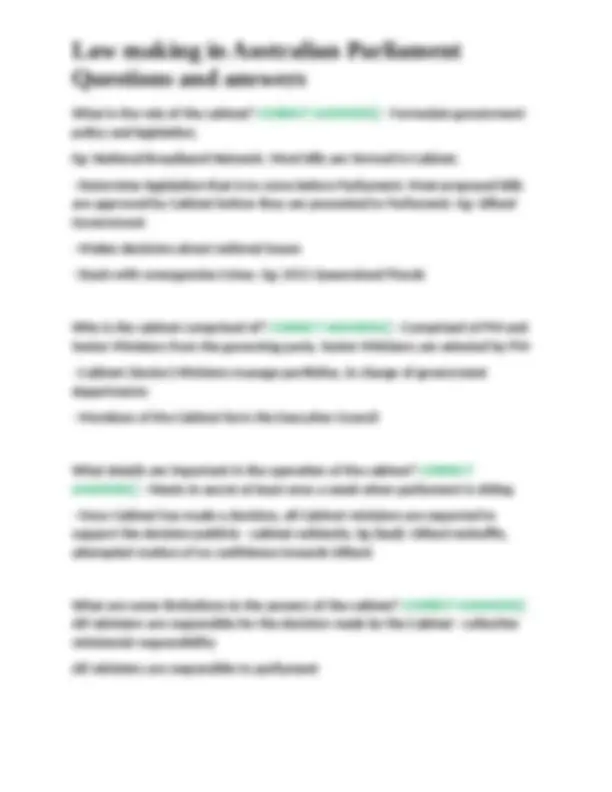
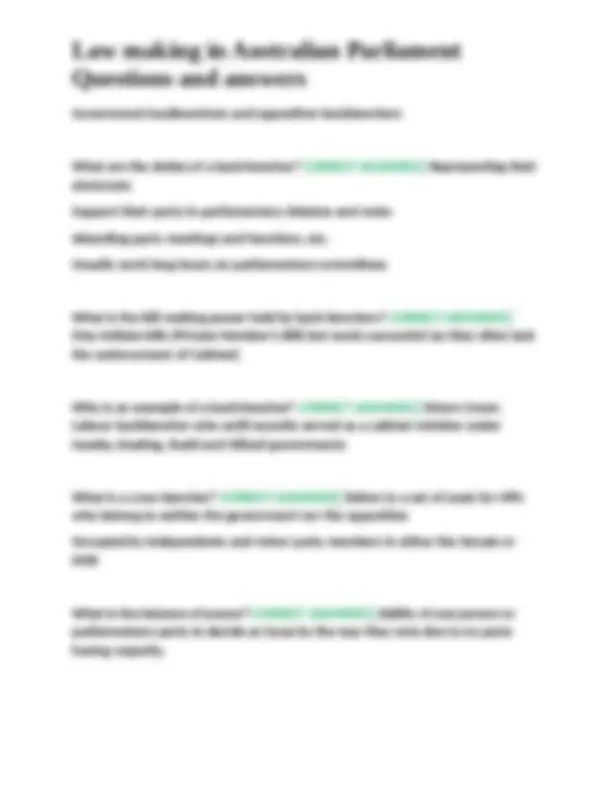
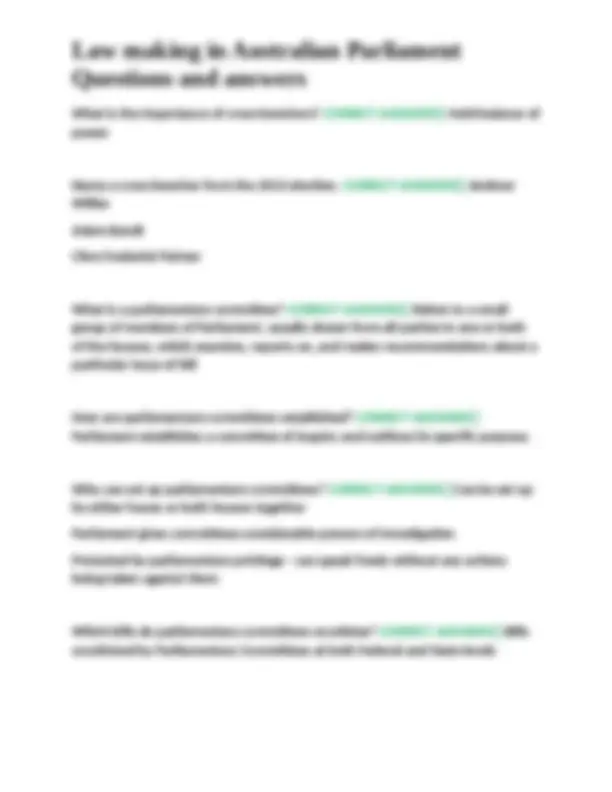
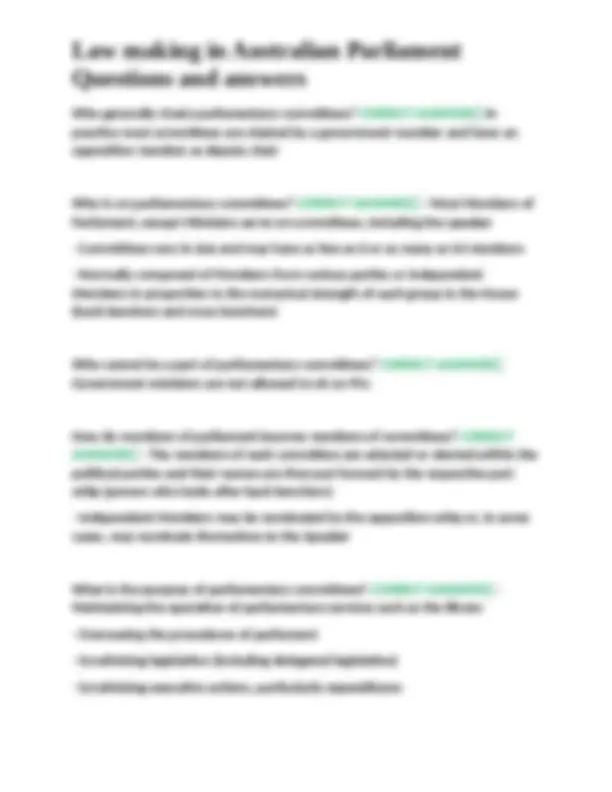
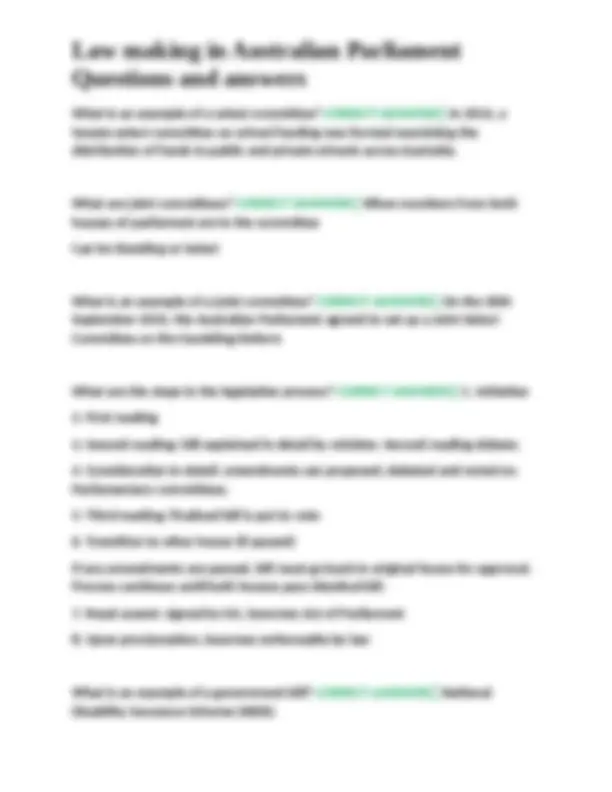
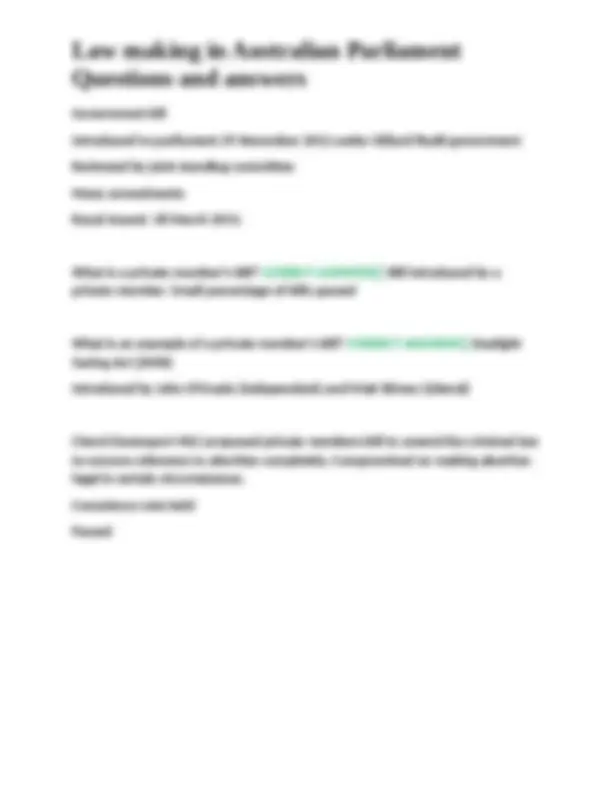


Study with the several resources on Docsity

Earn points by helping other students or get them with a premium plan


Prepare for your exams
Study with the several resources on Docsity

Earn points to download
Earn points by helping other students or get them with a premium plan
Community
Ask the community for help and clear up your study doubts
Discover the best universities in your country according to Docsity users
Free resources
Download our free guides on studying techniques, anxiety management strategies, and thesis advice from Docsity tutors
A comprehensive guide to the law making process in the australian parliament. It covers topics such as private member bills, government bills, the main functions of the australian parliament, parliamentary committees, the role of the prime minister, the cabinet, the shadow ministry, backbenchers, cross-benchers, and parliamentary committees. It also explains the steps in the investigative process of parliamentary committees and the features of standing and select committees.
Typology: Exams
1 / 19

This page cannot be seen from the preview
Don't miss anything!












Define private member CORRECT ANSWERS✅ Any member who does not hold an official office. Includes:
Does not take part in debates Cannot vote Elected through standing orders Keeps order in the house, enforces standing orders Can sanction members, send them out of the room Has casting vote in tied result What is the origin of the role of PM? CORRECT ANSWERS✅ Not mentioned in Constitution Established by convention Australia has had 28 Prime Ministers What is the parliamentary membership held by the PM? CORRECT ANSWERS✅ PM by CONVENTION is a member of the Lower House John Gorton: only PM in Senate. 19th Prime Minister of Australia. Resigned from Senate position and got a seat in the House of Reps. In office 10 January 1968 to 10 March 1971 Describe the position of the PM. CORRECT ANSWERS✅ Leader of the Australian Government Leader of the nation Leader of the Executive Government Leader of the political party with a majority of seats in the House of Representatives
Describe the role of the PM. CORRECT ANSWERS✅ Allocating ministerial positions Chairing cabinet meetings and set agenda (head of Cabinet) Right to advise the Governor General (exist only by Convention) Making decisions about national issues Dealing with emergencies/crises (eg: 2011 Queensland Floods) How is the PM appointed? CORRECT ANSWERS✅ Leader of elected party Governor General officially appoints PM, even though the Constitution does not recognise this position What are some restrictions on the PM's power? CORRECT ANSWERS✅ Maintaining support of their parliamentary colleagues in order to remain in position Managing strong political personalities and ambitions of cabinet ministers PM and other ministers must attend question time and submit to inquiries and scrutinies from the Opposition Prime Ministerial goals can be thwarted by court's role as constitutional interpreter means that. Eg: High Court invalidated Gillard's government's policy on Malaysia Solution Reserve powers of the Governor-General may be used against the Prime Minister. Eg: Sir John Kerr's dismissal of PM Whitlam in 1975 Opinion polls, by-elections. State elections and pressure group activity all contribute to electoral pressure on the person holding prime ministerial office
What is the role of the cabinet? CORRECT ANSWERS✅ - Formulate government policy and legislation. Eg: National Broadband Network. Most bills are formed in Cabinet.
Questioned on departments and bills during question time, when introducing bills List two current cabinet members. CORRECT ANSWERS✅ Treasurer: Joe Hockey MP Minister for Education: Christopher Pyne MP What is the role of the shadow ministry? CORRECT ANSWERS✅ Each shadow minister concentrates on the work of a particular minister and government department Who is the shadow ministry comprised of? CORRECT ANSWERS✅ Consists of 'Shadow Ministers' who are members of the opposition chosen by the Leader of Opposition What procedures are important in the operation of the shadow ministry? CORRECT ANSWERS✅ - Top-level shadow ministers form a Shadow Cabinet which meets regularly to develop opposition policies
Government backbenchers and opposition backbenchers What are the duties of a back-bencher? CORRECT ANSWERS✅ Representing their electorate Support their party in parliamentary debates and votes Attending party meetings and functions, etc. Usually work long hours on parliamentary committees What is the bill-making power held by back-benchers? CORRECT ANSWERS✅ May initiate bills (Private Member's Bill) but rarely successful )as they often lack the endorsement of Cabinet) Who is an example of a back-bencher? CORRECT ANSWERS✅ Simon Crean: Labour backbencher who until recently served as a cabinet minister under Hawke, Keating, Rudd and Gillard governments What is a cross-bencher? CORRECT ANSWERS✅ Refers to a set of seats for MPs who belong to neither the government nor the opposition Occupied by Independents and minor party members in either the Senate or HOR What is the balance of power? CORRECT ANSWERS✅ Ability of one person or parliamentary party to decide an issue by the way they vote due to no party having majority.
What is the importance of cross-benchers? CORRECT ANSWERS✅ Hold balance of power Name a cross-bencher from the 2013 election. CORRECT ANSWERS✅ Andrew Wilkie Adam Bandt Clive Frederick Palmer What is a parliamentary committee? CORRECT ANSWERS✅ Refers to a small group of members of Parliament, usually drawn from all parties in one or both of the houses, which examine, reports on, and makes recommendations about a particular issue of bill How are parliamentary committees established? CORRECT ANSWERS✅ Parliament establishes a committee of inquiry and outlines its specific purpose. Who can set up parliamentary committees? CORRECT ANSWERS✅ Can be set up by either house or both houses together Parliament gives committees considerable powers of investigation Protected by parliamentary privilege - can speak freely without any actions being taken against them Which bills do parliamentary committees scrutinise? CORRECT ANSWERS✅ Bills scrutinised by Parliamentary Committees at both Federal and State levels
How many current standing committees are there? CORRECT ANSWERS✅ 15 standing committees in HOR 16 standing committees in Senate What is an example of a standing committee? CORRECT ANSWERS✅ March 27 2013 House of Representatives Standing Committee on Aboriginal and Torres Strait Islander Affairs released its advisory report on the Native Title Amendment Bill 2012. The Committee had recommended that the bill be passed and says an inquiry into the present Native Title system should also be set up at the beginning of the next parliament. 26 March 2014: Standing Senate Committee on out-of-pocket costs in Australian healthcare What are the features of select committees? CORRECT ANSWERS✅ Short term, temporary committees Used to investigate a specific matter, often current controversial issues May be set up by minister or parliament Ceases to exist when it had made its final report to the house Which house uses select committees more? CORRECT ANSWERS✅ Select committees extensively used by Senate
Government bill Introduced to parliament 29 November 2012 under Gillard/Rudd government Reviewed by joint standing committee Many amendments Royal Assent: 18 March 2013. What is a private member's bill? CORRECT ANSWERS✅ Bill introduced by a private member. Small percentage of bills passed What is an example of a private member's bill? CORRECT ANSWERS✅ Daylight Saving Act (2006) Introduced by John D'Orazio (independent) and Matt Birney (Liberal) Cheryl Davenport MLC proposed private members bill to amend the criminal law to remove reference to abortion completely. Compromised on making abortion legal in certain circumstances. Conscience vote held Passed